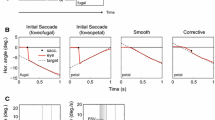Abstract
Recent neurophysiological studies of the saccadic ocular motor system have lent support to the hypothesis that this system uses a motor error signal in retinotopic coordinates to direct saccades to both visual and auditory targets. With visual targets, the coordinates of the sensory and motor error signals will be identical unless the eyes move between the time of target presentation and the time of saccade onset. However, targets from other modalities must undergo different sensory-motor transformations to access the same motor error map. Because auditory targets are initially localized in head-centered coordinates, analyzing the metrics of saccades from different starting positions allows a determination of whether the coordinates of the motor signals are those of the sensory system. We studied six human subjects who made saccades to visual or auditory targets from a central fixation point or from one at 10° to the right or left of the midline of the head. Although the latencies of saccades to visual targets increased as stimulus eccentricity increased, the latencies of saccades to auditory targets decreased as stimulus eccentricity increased. The longest auditory latencies were for the smallest values of motor error (the difference between target position and fixation eye position) or desired saccade size, regardless of the position of the auditory target relative to the head or the amplitude of the executed saccade. Similarly, differences in initial eye position did not affect the accuracy of saccades of the same desired size. When saccadic error was plotted as a function of motor error, the curves obtained at the different fixation positions overlapped completely. Thus, saccadic programs in the central nervous system compensated for eye position regardless of the modality of the saccade target, supporting the hypothesis that the saccadic ocular motor system uses motor error signals to direct saccades to auditory targets.
Similar content being viewed by others
Author information
Authors and Affiliations
Additional information
Received: 8 September 1995 / Accepted: 22 November 1996
Rights and permissions
About this article
Cite this article
Yao, L., Peck, C. Saccadic eye movements to visual and auditory targets. Exp Brain Res 115, 25–34 (1997). https://doi.org/10.1007/PL00005682
Issue Date:
DOI: https://doi.org/10.1007/PL00005682




